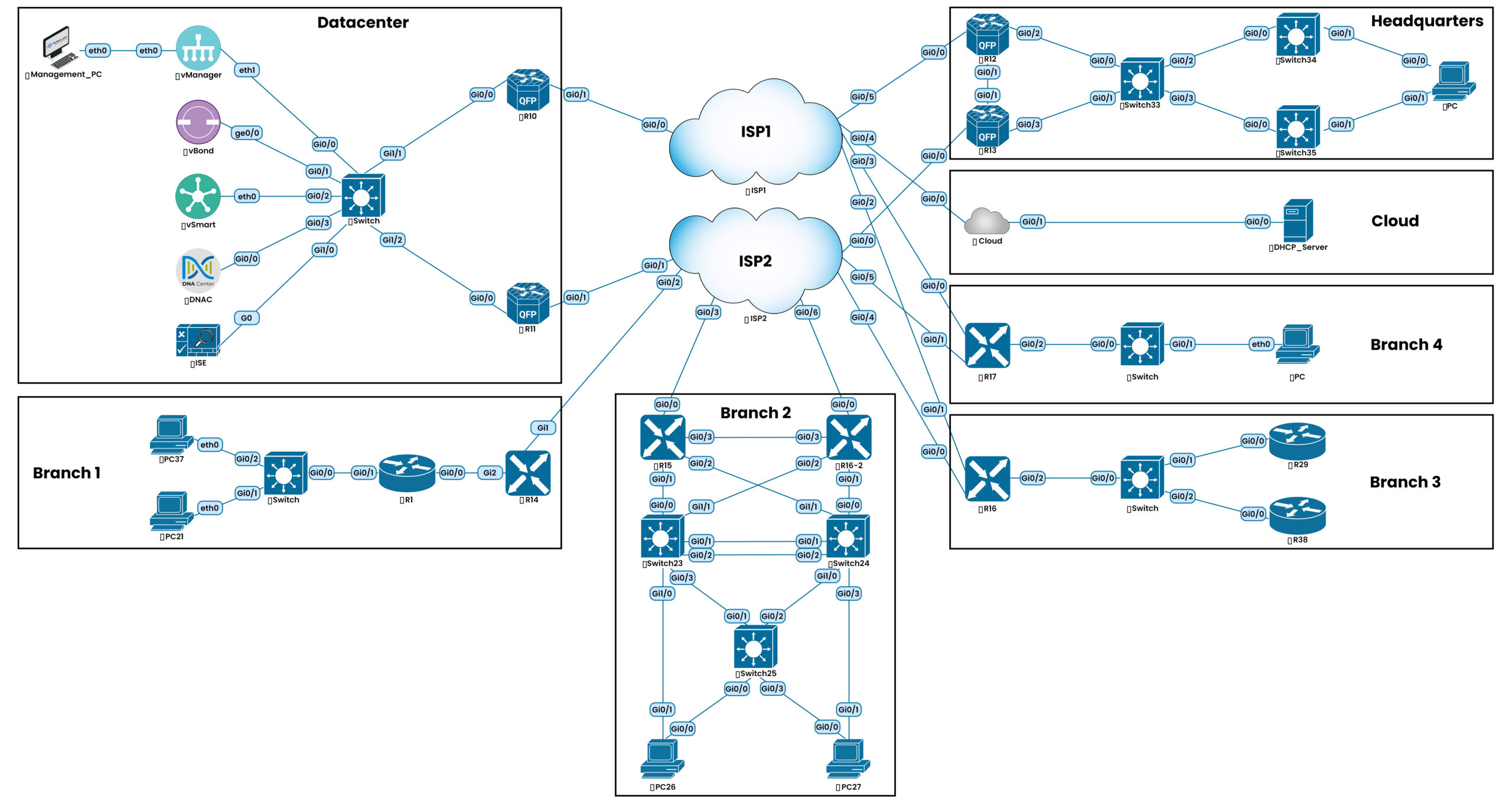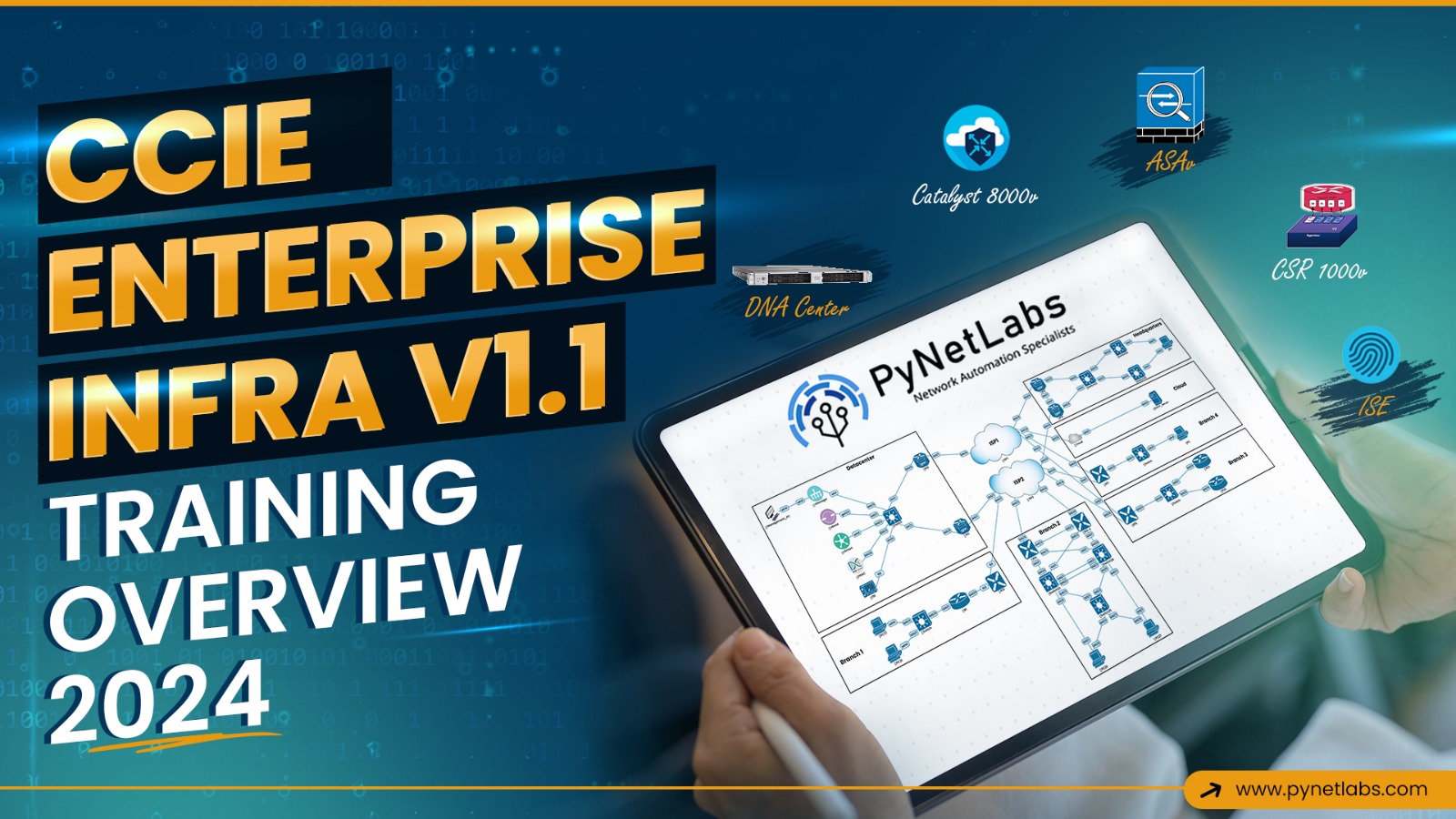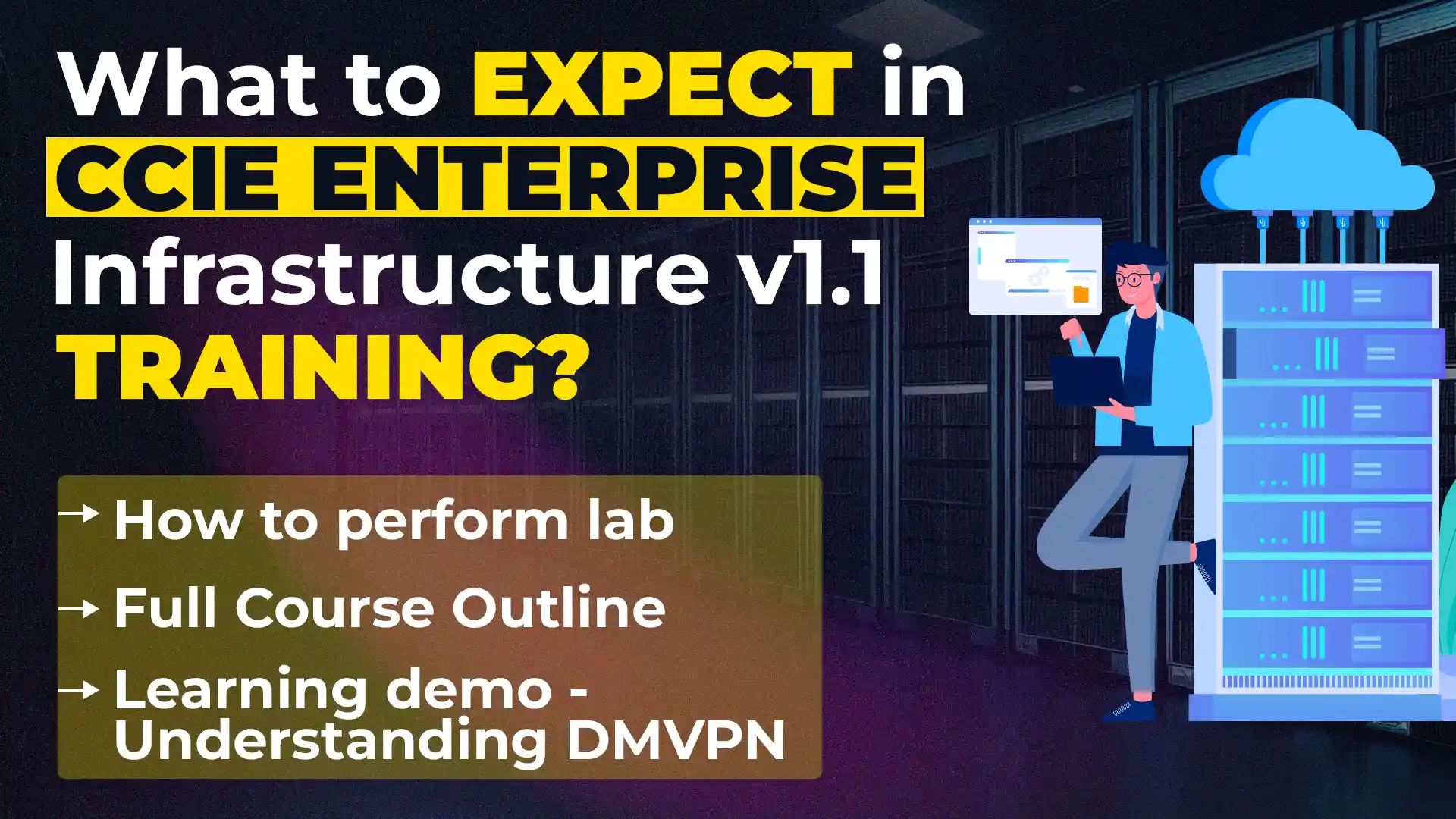CCIE Enterprise Infrastructure Training
CCIE Enterprise Infrastructure
Training V1.1
Start your CCIE Enterprise Infrastructure Training with Mr. Chirag Dhall #68677 and take your networking career to the next level. Our expert guidance will equip you with the skills and confidence needed to pass your CCIE Enterprise lab exam – aiming for success on your very first attempt!
COURSE OVERVIEW
Do you also want to advance in your networking career? If yes, then you are at the right place. CCIE EI Training is the perfect way for any networking professional to reach the highest level of expertise in enterprise networking.
The expert level of the Enterprise track is known as CCIE Enterprise Infrastructure, and the CCIE Enterprise Infrastructure training by PyNet Labs will cover the latest version 1.1.
Our program is structured into five modules, ENCOR 350-401, ENARSI 300-410, Cisco SD-WAN, SD-Access, and Network Automation & Programmability. Each module in the CCIE Enterprise Infrastructure Training covers the necessary knowledge and hands-on skills required to excel in the challenging CCIE Enterprise Infrastructure exam.
Throughout the CCIE Enterprise Infrastructure training, we will take you from foundational concepts of ENCOR to advanced techniques of Automation. Within each training module, we will start building labs with 24*7 unlimited lab access and after all this, you will be working on the main labs that will help you to prepare for the actual lab exam of the CCIE Enterprise Infrastructure Blueprint.
Also, if you are familiar with the ENCOR & SDWAN concepts, then you can skip these modules and dive straight to other modules of CCIE Enterprise training.
What to expect in the CCIE Enterprise Infrastructure Training V1.1
UPCOMING BATCHES
CCIE Enterprise Infrastructure Training
DATE
TIME
SEATS LEFT
Starting from 26th Oct 2024
Weekend batch
(Saturday & Sunday)
5 PM to 8 PM Indian Time
7: 30 AM to 10: 30 AM Eastern Time
11: 30 AM to 2: 30 PM UTC/ GMT00
Sold out
Starting from 23rd Dec 2024
Weekday batch
(Monday to Thursday)
8 AM to 11 PM Indian Time
9: 30 PM to 12: 30 AM Eastern Time
2:30 AM to 5:30 AM UTC/GMT00
Sold out
Starting from 22nd Feb 2025
Weekend batch
(Saturday & Sunday)
1 PM to 4 PM Indian Time
2: 30 AM to 5: 30 AM Eastern Time
7: 30 AM to 10: 30 AM UTC/GMT00
Sold Out
Download Course Outline
Enquire Now
UPCOMING BATCHES
CCIE Enterprise Infrastructure Training
DATE
Starting from 26th Oct 2024
Weekend batch
(Saturday & Sunday)
TIME
5 PM to 8 PM Indian Time
7: 30 AM to 10: 30 AM Eastern Time
11: 30 AM to 2: 30 PM UTC/ GMT00
SEATS LEFT
Sold out
DATE
Starting from 23rd Dec 2024
Weekday batch
(Monday to Thursday)
TIME
8 AM to 11 PM Indian Time
9: 30 PM to 12: 30 AM Eastern Time
2:30 AM to 5:30 AM UTC/GMT00
SEATS LEFT
Sold out
DATE
Starting from 22nd Feb 2025
Weekend batch
(Saturday & Sunday)
TIME
1 PM to 4 PM Indian Time
2: 30 AM to 5: 30 AM Eastern Time
7: 30 AM to 10: 30 AM UTC/GMT00
SEATS LEFT
Sold Out
Download Course Outline
ENQUIRE NOW
What is CCIE Enterprise Infrastructure?
The Cisco Certified Internetwork Expert in Enterprise Infrastructure is an expert-level certification provided by Cisco. It mainly focuses on topics including designing, implementing, and troubleshooting complex network infrastructures. One can showcase their expertise with complex enterprise infrastructure solutions, from designing and deploying to operating and optimizing.
Routing and Switching are the essential skills that every network engineer should be familiar with. The CCIE EI Certification focuses on Routing and switching technologies in addition to other most-demanded technologies, making its scope evergreen in the networking industry.
Prerequisites for CCIE EI Training v1.1
According to Cisco, there are no formal prerequisites for CCIE EI Training. However, to maximize the benefits of this training, candidates should have prior networking knowledge, including all CCNA topics, and a few years of experience in the networking domain. It will be cherry on top if one has a basic understanding of CCNP Enterprise Topics.
So, if you have CCNA Knowledge, you can start with CCIE Enterprise Infrastructure Training from PyNet Labs.
Why choose CCIE Enterprise Infrastructure Training?
Preparing for a CCIE EI v1.1 certification exam requires rigorous training and knowledge of complex networking topologies. The passing rate of CCIE exams is low. So, taking good CCIE EI Training is recommended to prepare and clear your CCIE Enterprise exam on the first try. Here are some other reasons why enrolling in CCIE Enterprise Training can set you apart:
- Hands-on Skills: Our Training program offers unlimited lab access, allowing you to try various networking scenarios and gain hands-on experience with enterprise infrastructure.
- Comprehensive Curriculum: Our training covers all the important advanced topics, including SD-WAN, Automation, Security, SD-Access, etc.
- High Earning Potential: CCIE-trained individuals get higher pay than other individuals, and CCIE-certified professionals are among the top-paid professionals in the networking domain.
- Global Recognition: CCIE Enterprise is a well-recognized and respected certification around the world. The CCIE EI Training can prepare you to take on this certification.
- Career Advancement: It can open doors to advance career opportunities in the networking domain, such as network architects, senior network engineers, etc.
CCIE
Enterprise
Infrastructure Training v1.1 Details
![]()
-
Training Duration:
100 Hours of Instructor-Led Online Training -
End-to-End Support:
For Exam Consultation -
Lifetime Access:
To Live Recorded Classes and Telegram Groups for doubts -
Course Outline :
Follows Official Exam Blueprint -
24*7 Unlimited:
Lab Access through VDI to each participants -
Training Prerequisites:
CCNA 200-301
CCIE ENTERPRISE INFRASTRUCTURE TRAINING OUTLINE
Module 1 (30 Hours): Skippable, if you are familiar with CCNP ENCOR 350-401.
Switched Campus
- Configuring and verifying basic layer 2 operations
- Configuring and verifying layer 2 protocols: CDP, LLDP, UDLD
- Configuring and verifying VLANs and Trunks, Voice VLAN
- Configuring and verifying EtherChannel
- Configuring and verifying STP, RSTP, MST, and related features
Routing Protocols
- Configuring IPv4 and IPv6 static routing
- OSPF
-
-
- Configuring OSPF Adjacencies
- Configure simple OSPFv2/v3 environments, including multiple normal areas, summarization, and filtering.
-
- BGP
-
-
- Configure and verify BGP between directly connected neighbors
- Understanding best path selection algorithm and neighbor relationships
-
- Routing Concepts
-
-
- Configuring Policy-Based Routing
- Configuring VRF Lite
- Configuring Routing Protocol Authentications
-
Wireless
- Describe Layer 1 concepts, such as RF power, RSSI, SNR, interference, noise, bands, channels, and wireless
client devices capabilities - Describe AP modes and antenna types
- Describe access point discovery and join process (discovery algorithms, WLC selection process)
- Describe the main principles and use cases for Layer 2 and Layer 3 roaming
- Troubleshoot WLAN configuration and wireless client connectivity issues using GUI only
- Describe wireless segmentation with groups, profiles, and tags
- Configure and verify wireless security features : 802.1X, WebAuth, PSK, EAPOL (4-way handshake)
IP Services and Security
- Configuring Time Synchronization Protocols: NTP, PTP
- Configure NAT/PAT
- Configuring FHRP: HSRP, VRRP
- Understanding multicast protocols, such as RPF check, PIM and IGMP v2/v3
- Interpret wired and wireless QoS configurations
o QoS components
o QoS policy - Lines and local user authentication
- Configuring Control Plane Policing and Protection
- Configuring AAA
- ACLs
- Configuring wireless security features: 802.1X WebAuth PSK EAPOL (4-way handshake)
- Understanding the components of network security design:
o Threat defense
o Endpoint security
o Next-generation firewall
o TrustSec and MACsec
o Network access control with 802.1X, MAB, and WebAuth - Understanding network diagnosing tools like : debugs, conditional debugs, traceroute, ping, SNMP, and syslog
- Configure and verify Flexible NetFlow
- Configure SPAN/RSPAN/ERSPAN
- Configure and verify IPSLA
Virtualization
- Understanding device virtualization technologies:
o Hypervisor type 1 and 2
o Virtual machine
o Virtual switching - Configure static point-to-point GRE tunnels between two sites.
- Configuring and verifying IPsec tunnelling.
- Describing LISP and VXLAN.
Module 2 (30 Hours): Contains the content of CCNP ENARSI and additional topics that will help you understand the depth of networking technologies.
Routing Protocols:
EIGRP
- Configuring EIGRP Adjacencies
- Understanding EIGPR Best Path Selection, EIGRP Metric, Feasibility Condition
- Configuring and verifying EIGRP Operations: Topology Table, Stuck-In-Active, Graceful Shutdown
- Configuring EIGRP Named Mode
- Configuring Leak-Map with Summary Routes
- Configuring EIGRP stub with Leak-Map
OSPF
- Configuring OSPFv3 address family
- Configuring OSPF Network Types and Area Types
- Exploring OSPF Path Preference Decisions
- Configuring and verifying OSPF Operations: Graceful shutdown, GTSM
- Configuring and verifying OSPF optimization options: SPF Tuning, LSA Throttling, Stub router, Prefix
Suppression.
BGP
- Configuring Peer Groups and templates, Active/Passive Connections, Timers, ynamic Neighbors
- Verifying and Manipulating default Path Selection Criteria
- Configuring Routing Policies: Attribute Manipulation, Conditional Advertisements, Route filtering,
Communities, Multihoming - Configuring AS Path manipulations
Multicast
- Configuring and verifying Layer2 Multicast
- Configuring and verifying Reverse Path Forwarding Check
- Configuring PIM: Sparse Mode, Static RP, BSR, Auto-RP
- Configuring Group-to-RP mapping
- Configuring Source Specific Multicasting
- Configuring Multicast Boundary, RP Announcements
- Configuring PIMv6 anycast RP
- Configuring Anycast RP using MSDP
- Configuring Multicast Multipath
Routing Concepts
- Configuring VRF Aware Routing, Route leaking between VRF
- Configuring Route Filtering
- Configuring Redistribution
- Configuring BFD (Bidirectional Forwarding Detection)
- Configuring L3 MTU
IP Services and Security:
- Configuring Switch security features like VACL, PACL, Storm Control, DHCP Snooping, IP Source Guard,
Dynamic ARP Inspection, Port Security - Configuring Router Security Features like IPv6 Traffic Filter, URPF
- Configuring IPv6 Infra Security features like RA Guard, DHCP Guard, Binding Table, Device Tracking, ND
Inspection/snooping, Source Guard - Quality of Service
- Configuring DSCP
- Configuring Classification and trust boundary
- Configuring NBAR
- Marking DSCP Values
- Configuring Policing and Shaping
- Configuring Congestion management and avoidance
- Configuring HQoS
- End to end layer3 QoS using MQC
-
Network Services
- Configuring IPv6 RS/RA
- Configuring DHCP: DHCP Configurations, DHCP Options, SLAAC/DHCPv6 Integration, Stateful,
Stateless DHCPv6, DHCP Prefix Delegation - Configuring NAT: Static, Dynamic, Policy Based, VRF Aware, VRF Aware Software Infrastructure (VASI)
- Tracking Objects and lists
Transport Technologies
- Configuring and verifying the MPLS network with multiple LSRs
o Troubleshooting using MPLS Ping and MPLS traceroute. - Configuring L3 VPN
o Establishing L3VPN between PE and CE routers.
o Configuring basic MPBGP for L3VPN
o Verifying end-to-end connectivity between devices. - Configuring DMVPN
o Configuring NHRP for dynamic spoke-to-spoke communication
o Implement IPsec/IKEv2 using the pre-shared key for secure communication
o Troubleshooting DMVPN with dual hub
Module 3 (16 Hours): Skippable, if you are familiar with Cisco SD-WAN.
Cisco SD-WAN
- Understanding SDWAN Architecture
- Control plane and data plane operations
- Deploying controller site
- Deploying branch sites
- Understanding Overlay Management Protocol (OMP) architecture
- Configuring Templates
- Configuring network segmentation using service VPN between branches
- Implementing Direct Internet Access (DIA)
- Configuring Centralized Policies: Data Policies, Application-Aware Routing Policies, Control Policies, hub and spoke
- Localized Policies: Access Lists, Route Policies
Module 4 (16 Hours): Contains the content of SD-Access.
Cisco SD-Access
- Configuring Underlay: Manual Configurations, LAN Automation, Device Discovery and Management, Extended Nodes/Policy Extended Nodes
- Configuring Overlay: LISP, BGP Control Planes, VXLAN Data Plane, Cisco TrustSec Policy plane, L2 Flooding, Native Multicast
- Fabric Designing and Deployment: Single Site/Multisite, Fabric in a box, Host onboarding, Authentication, Port Configuration, Multisite remote border, Border Priority, Adding devices.
- Fabric Border Handoff: SDA, SDWAN, IP Transits, Peer Device, Layer 2 border handoff
- Configuring Segmentation
Module 5 (8 Hours): Contains the content of Network Automation & Programmability.
-
Understanding the fundamentals
-
Fundamental Python programming
▪ Python data structure
▪ Using Python to read from and write to a file
▪ Python loops and conditional code
- Configuring IOS Devices using NETMIKO
- Configure and verify NETCONF and RESTCONF
- Introduction to RESTAPIs
- Introduction to HTTP Request/Response model
- Understanding the HTTP status codes
- Creating queries to interact with the device
-
-
Automation and Scripting
- Creating EEM Applets
- Introduction to Linux
- CLI Python module
- EEM Python Module
-
Programmability
- Interaction with vManage API using requests library and Postman
- Interaction with DNA Center using HTTP requests
- Deploying and verifying model-driven telemetry
PyNet Labs Training Video Demo
What makes Our CCIE EI Training Unique?
- Certified Instructure: Learn from a Cisco Certified Instructure with real-world experience.
- 24*7 Lab Access: We provide unlimited lab access to all our participants so they can practice as much as they want.
- Up-to-date Course Content: At PyNet Labs, we strictly follow the latest course curriculum to help you prepare with the latest syllabus.
- Exam Preparation and Support: We also offer comprehensive support for your exam preparation, including mock tests, troubleshooting practice, and lab assignments. It also includes Exam Consultation & End to End Support for Lab Exam Attempts.
- Flexible Learning Options: You can choose from various training options that fit your needs. There are options for weekday or weekend classes and fly-me-a-trainer or online classes.
- Quality vs Quantity Training: We only take 5 to 10 students per batch for a focused learning experience.
- Post-training Support: Unlike other institutes, we stay connected with you even after you complete your training. We have dedicated Telegram groups for every batch to discuss and clear your doubts after classes.
- Lifetime Access: You will get lifetime access to all CCIE EI Training classes for your life. You can choose to watch it whenever you like.
The topology that will help you prepare all CCIE Enterprise Infrastructure v1.1 Topics

Devices used in the topology
-
Cisco CSR 1000v -
Cisco IOSv with Cisco IOS Software -
Cisco IOSv-L2 with Cisco IOS -
Cisco SD-WAN (vManage, vBond, vSmart, vEdge)
-
Cisco DNA Center -
Cisco ASAv -
Cisco Catalyst 8000v -
Cisco ISE
Preparing for the CCIE Enterprise Infrastructure
Lab Exam
To earn the CCIE Enterprise Infrastructure certification, you must clear two exams: a core exam (ENCOR 350-401) and a practical exam. You need to clear the ENCOR exam to take the Lab exam.
- ENCOR 350-401 Exam tests your fundamental knowledge of core enterprise infrastructure topics.
- CCIE EI Lab Exam is an 8-hour-long lab test focusing on real-world scenarios and network troubleshooting.
Meet Your Trainer

Chirag Dhall
(Corporate Trainer at PyNet Labs)
(CCIE EI #68677)
Mr. Chirag is a young and dynamic trainer at PyNet Labs delivering CCNA, CCNP ENCOR, CCNP ENARSI, CCIE Enterprise, Python for Network Engineers, CCNA DevNet, and Ansible basics training. He has been actively involved in training over 1000+ students in the past on CCNA, CCNP, CCIE, and DevNet technologies. He also has good experience with VMware virtualization, and he is taking multiple corporate batches for PyNet Labs. He understands the problems of freshers, networking professionals, and engineering students very easily and solves them with a unique technique that the training participants fall in love with the technology.
Still have any doubts?
Frequently Asked Questions
Will I get end-to-end CCIE Enterprise Infrastructure lab exam passing support?
Yes, end-to-end Lab exam passing support will be provided during and after training completion till you get your CCIE Enterprise number.
What kind of support will I receive during my CCIE Enterprise Infrastructure training?
Apart from Instructor-led online training, you will have 4-5 months of 24/7 lab access, study materials, ongoing training support and guidance from the instructor, study groups and peer support until you become certified.
What if I miss any session due to some unavoidable reason?
If you miss any live session, we will make sure you have a recording available for the same, but in case you are about to miss the whole course due to shift change or any personal family reasons, you can inform our team and we will block your lab access at that time and activate it when you are back and help you sit in the ongoing batch at that time.
What will be the Lab Access Tenure?
You will have access to our unlimited labs till the CCIE Enterprise training time period plus you will have 1-month complementary labs for practicing.
In a day, how many dedicated hours will be given to perform the labs?
There will be No Restrictions in terms of number of hours. You will have unlimited 24*7 Lab access.
I am familiar with CCNP ENCOR, can I skip this from the course?
Yes, you can skip the ENCOR module and proceed with the remaining 4 modules of CCIE Enterprise
I am familiar with Cisco SDWAN, can I skip this from the course?
Yes, you can skip the SDWAN module and proceed with the remaining 4 modules of CCIE Enterprise Infrastructure training.



